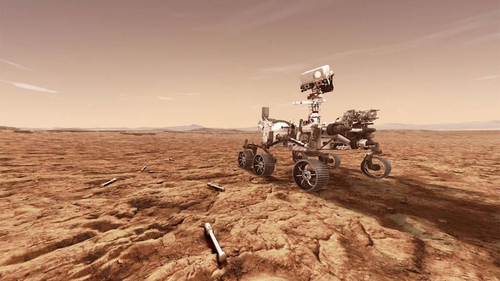If the site is not confirmed, it is confirmed as a sample to be brought to the earth in 10 years.
Could Perseverance, the fifth US rover, settled in what is believed to be an ancient delta near the Mars equator, could give the final answer to the existence of life on the Red Planet?
Since Galileo Galilei first observed Mars with a telescope in 1609, humans have been paying attention to Mars, and questions about the existence of life on Mars have always been followed.
A state-of-the-art rover with a total amount of $2.7 billion (2.97 trillion) is put in, and as it is a top priority in finding traces of ancient life, there is high hope that the answer will be available this time.
 |
| ▲ Rock formation of the Turkish Lake Salda formed by ancient microorganisms trapped in minerals and sediments. As an example, Perseverance finds traces of this type of life in craters. |
According to the National Aeronautics and Space Administration (NASA) Jet Propulsion Research Institute (JPL), the landing site’Jezero Crater’ is known as an ancient lake formed up to the delta from sediments carried by rivers about 3.5 billion years ago.
JPL’s astrobiologists are expecting traces of life await somewhere on the bottom of an ancient lake, which is 45km wide, or at the edge of 600m high.
After a month of preparation work, such as equipment inspection and software upgrade, the Perservance will travel about 25 km for two years to engage in exploration activities.
 |
| ▲ Imagination of rock and soil samples collected by Perservance to send to Earth. |
Although the sediment at the bottom of the lake or on the shore is the most potent place to find traces of life, it is said to open up all possibilities. On Earth, lake floors and lakeside sediments are rich in carbonate minerals, which are particularly well preserved for microbial fossils.
Perseverance is equipped with the most necessary advanced equipment to find traces of life based on the activities of previous rovers, such as’Curiosity’ currently active in’Gale Crater’.
First, when the’MastCam-Z’, a camera mounted on the rover’s mast, finds an object of scientific interest,’SuperCam’ creates a small amount of gas with a laser and analyzes the chemical composition. After passing through this process, if it is determined that it is worth precise analysis, two advanced analysis equipment mounted on the rotating plate at the end of the robot arm will be launched.
One is the’Planetary X-ray Litochemistry Equipment’ (PIXL), which irradiates powerful X-rays to find chemical evidence left by ancient microorganisms. The other is the’Raman and Fluorescence Scanning of Organics and Chemicals in Habitable Environment’ (SHERLOC) equipment that uses its own laser to detect organic molecules and minerals formed in the underwater environment.
These two instruments provide detailed information about elements, minerals and molecules in rocks and sediments, allowing astrobiologists to evaluate their composition and decide whether to bring samples to Earth for further analysis.
Scientists hope to find convincing evidence that can be confirmed by appearance alone, such as stromatolite, a layered sedimentary structure created by the growth of the microorganism cyanobcteria on the shores of the Earth’s ancient coast.
If such evidence is not found, or if the field analysis of the perseverance is insufficient, only the method of bringing a sample to Earth and analyzing it with ultra-high-performance equipment will be able to give a definite answer to the existence of life.
The core sample obtained by drilling a hole in the rock by Perservance is placed in a cigar-type titanium container and placed on site. The lander and rover that will be jointly launched by NASA and the European Space Agency (ESA) are collected along the path of Perservance and collected. Will be sent to. As of now, that period is scheduled for about 10 years.
Ken Williford, director of JPL’s abc Lab, said, “Even if we come to the conclusion that there was no life in the ancient lakes from the samples brought to Earth, we will learn important things about the range of life in the universe.” Regardless of whether or not life has lived, it is essential to understand how rocky planets like ours formed and evolved, and why they became desolate unlike Earth.”
<연합>
International Team [email protected]
<저작권자 © 전파신문, 무단 전재 및 재배포 금지>
